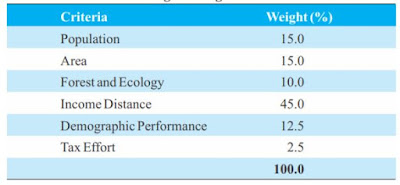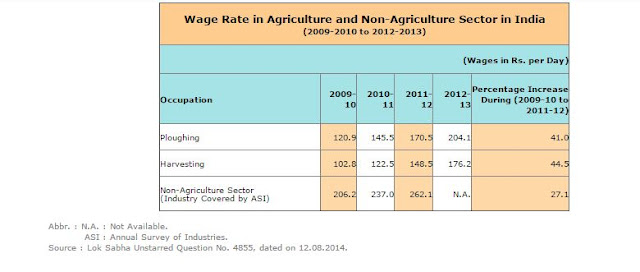The main aim behind horizontal devolution is to equalize the provisions for public goods and services in states. Finance Commission of India aims to fill the vertical fiscal gap (i.e. matching the revenue and expenditure of different government level, to achieve the horizontal equity (by allocating the higher share to poorest states), to equalize the fiscal capacities of state i.e. rervenue equalization, to equalize expenditure by providing the cost differentials for public services and to create the incentive for states to mobilize own revenue and spend it efficiently.
Criteria and Weights in Previous Finance Commissions
Criteria and Weights in provided by XVth Finance Commissions
The recent finance commission includes the criteria called demographic performance as 2011 population data is used instead of 1971. Therefore the states who successfully reduced the population raised the concern and therefore criteria for demographic performance (criterion for total fertility rate (TFR)) are added to avoid the adverse impact of including 2011s population data.
Now the point is whether the efforts take by the finance commission are getting reflected in the achievements or not. The disparity among states is still not declining. In this article, I am going to construct the indices to measure the disparity among states. I will discuss the methodology and trends and in the next article, I will continue the analysis.
Milanovic (2012) discusses three concepts of global inequality. According to the first concept, each country is assumed as one individual. And per capita GDP of that country is assumed as the income of that individual and then inequality indices are calculated. But here the population is ignored. So let's discuss two scenarios. In the first scenario, a country with high population witnesses an increase in income which means a significant portion of the population has witnessed an increase in income. In the second scenario, a country with small population witnesses the same increase in income. But compared to the first scenario, a small portion of the population is getting benefitted. Therefore the first scenario will witness a high reduction in inequality compared to the second scenario But according to this first concept, inequality will be the same in both scenarios as the population is ignored. Therefore the second concept is proposed where the population is weight is given. According to this concept, if a country with 20 Rupees per capita GDP has 100 population and another country has 30 Rupees per capita GDP and 200 population then inequality indices are calculated by assuming that 100 individuals have 20 Rupees income and 200 individuals have 30 Rupees income. Now if a big country witnesses significant growth then the concept will show a significant decline. But again as 100 individuals have the same 20 Rs income, it ignores within-country differences as every individual has a different income. Therefore the third concept calculates the inequality indices based on the actual income of individuals.
Now based on these three concepts, I tried to calculate the inequality measurement to measure the interstate disparity. The increase in inter-state inequality can be explained by three things: first, the rich states witness the increase in income and poor states witness a small increase in income compared to the rich states/no change in income/decline in income. Second, the rich states have a stable income but poor states are actually witnessing a decline in income. Third, the income of the rich state is falling but the income of poor states is falling rapidly.
Data source: I have calculated the inter-state disparity based on the NSO per capita NSDP data and Census data. The methods used to calculate the disparity is proposed by Milanović(2012). Gini for concept 3 is taken from the World Income Inequality Database (the WIID)
Now figure suggests that disparity is increasing and growth for all states is positive. So the second and third scenarios can be rejected. Now here the populous state in India is not performing well compared to the least populated states as concept 2 Gini is increasing adding to that this gap in performances in small states and highly populated states is very high because concept one Gini is higher than concept two Gini. This suggests that the highly populated states in India have positive but very small growth compared to the least populous states. But in 2018 more specifically in 2019, the concept 2 Gini is higher than concept 1 which suggests that in this period, highly populated states are performing very badly. (In such cases, the least populated states are growing rapidly but highly populated states are not witnessing a significant positive change in income (Initially they did have a positive change in income)).
Are highly populated states really creating problems?
Now let's play with the numbers. As we have discussed concept two of inequality (weighted Gini coefficient), let's try to get the different Gini coefficients with different weights.
Now there are three scenarios. Assume that there are 4 states, A B C D with per capita GDP 100, 200, 300, 400 and population 3000, 4000, 1000, 2000 respectively. In the first scenario, inequality is calculated by giving the weights (actual population). In the second scenario, we will change the weights. Assume that because of the hypothetical efforts, population size is changed and now the poor state has less population and the rich state has more population. In the given example, now A B C D states have 100, 200, 300, 400 per capita GDP and 1000, 2000, 3000, 4000 population. Now with these weights, the Gini coefficient is calculated. And now in the last scenario, we will do the reverse thing. Now the rich state has a low population and the poor state has a high population. A B C D states have 100, 200, 300, 400 per capita GDP and 4000, 3000, 2000, 1000 population respectively. Then with these weights, the Gini coefficient is calculated. Now let's discuss these three scenarios for Indian states.

Now let's discuss the above graph in detail. Scenario 2 and scenario 3 Gini coefficients lie below scenario one. It means in both scenarios where the population is shuffled, the disparity is declining. Now the point is which scenario is more efficient as well as more equitable? In the third scenario, poor states are highly populated and rich states are less populated. So if we calculate the weighted mean, then it will be smaller than the weighted mean of scenario one. Now in the second scenario, poor states are less populated while rich states are highly populated. So if we calculate the weighted mean, it will be higher, higher than both scenarios. (But one thing can be captured from the above graph is that the disparity among states exists not because rich states are performing "extraordinary" but poor and relatively populated states are performing poorly as scenario one Gini is higher than other scenarios Gini coefficient.).
The above figure shows precisely the same thing. The weighted mean for scenario 2 is very high where the weighted mean for scenario three is smaller than both scenarios. Scenario 3 reflects the loss. The relative distribution of the pie is declining but the size of the pie is shrinking. Therefore scenario 3 is not a solution. Scenario 2 is actually efficient as well as equitable because the weighted mean is high and disparity among states is low. What is scenario 2? In scenario two, we have reallocated the population. In this scenario, Uttar Pradesh is the richest state and Sikkim is the poorest state. But scenario 2 is right now hypothetical.

(I have calculated the population by using the exponential growth rate).
If we observe the above tables, we can see that in both periods states (many states) lie in the upper right and lower left. States at the lower end of the population are at the higher end in income. Similarly, states at the higher-end in the population are at the lower end in income (The tables are not strong evidence but we can at least say that there is almost no rich state that has a high population and there is almost no poor state that has a low population.) And that is a problem. The highly populated states have to perform "extraordinary" and that will improve equality as well as that will push India's income up. The fiscal transfer makes sense as according to the criteria, poor states in India are getting double (1st income distance and 2nd population gives more weight to the poor states which are highly populated). So fiscal transfers based on new criteria (i.e based on new population) are actually targeting issues related to both efficiencies as well as equality. But the million-dollar question is: previous financial commission also provided weights for the population as well as income distance. But still, the disparity is increasing. Why?
We will try to answer this question in the next article.
References
Milanovic, B. (2012). Global income inequality by the numbers: in history and now-an overview. The World Bank.








.jpeg)

टिप्पण्या
टिप्पणी पोस्ट करा